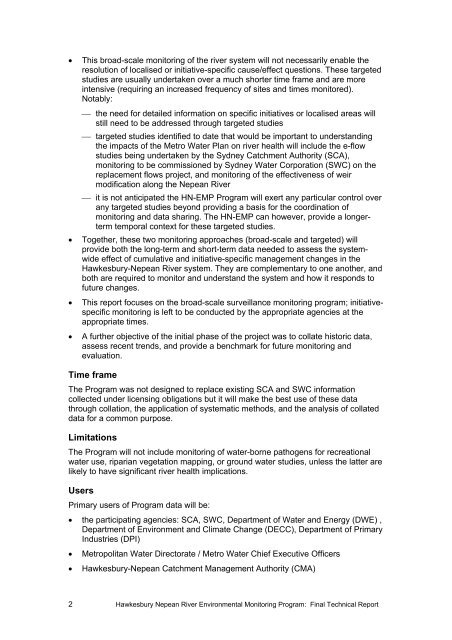Hawkesbury-Nepean River Environmental Monitoring Program
Hawkesbury-Nepean River Environmental Monitoring Program
Hawkesbury-Nepean River Environmental Monitoring Program
Create successful ePaper yourself
Turn your PDF publications into a flip-book with our unique Google optimized e-Paper software.
• This broad-scale monitoring of the river system will not necessarily enable the<br />
resolution of localised or initiative-specific cause/effect questions. These targeted<br />
studies are usually undertaken over a much shorter time frame and are more<br />
intensive (requiring an increased frequency of sites and times monitored).<br />
Notably:<br />
⎯ the need for detailed information on specific initiatives or localised areas will<br />
still need to be addressed through targeted studies<br />
⎯ targeted studies identified to date that would be important to understanding<br />
the impacts of the Metro Water Plan on river health will include the e-flow<br />
studies being undertaken by the Sydney Catchment Authority (SCA),<br />
monitoring to be commissioned by Sydney Water Corporation (SWC) on the<br />
replacement flows project, and monitoring of the effectiveness of weir<br />
modification along the <strong>Nepean</strong> <strong>River</strong><br />
⎯ it is not anticipated the HN-EMP <strong>Program</strong> will exert any particular control over<br />
any targeted studies beyond providing a basis for the coordination of<br />
monitoring and data sharing. The HN-EMP can however, provide a longerterm<br />
temporal context for these targeted studies.<br />
• Together, these two monitoring approaches (broad-scale and targeted) will<br />
provide both the long-term and short-term data needed to assess the systemwide<br />
effect of cumulative and initiative-specific management changes in the<br />
<strong>Hawkesbury</strong>-<strong>Nepean</strong> <strong>River</strong> system. They are complementary to one another, and<br />
both are required to monitor and understand the system and how it responds to<br />
future changes.<br />
• This report focuses on the broad-scale surveillance monitoring program; initiativespecific<br />
monitoring is left to be conducted by the appropriate agencies at the<br />
appropriate times.<br />
• A further objective of the initial phase of the project was to collate historic data,<br />
assess recent trends, and provide a benchmark for future monitoring and<br />
evaluation.<br />
Time frame<br />
The <strong>Program</strong> was not designed to replace existing SCA and SWC information<br />
collected under licensing obligations but it will make the best use of these data<br />
through collation, the application of systematic methods, and the analysis of collated<br />
data for a common purpose.<br />
Limitations<br />
The <strong>Program</strong> will not include monitoring of water-borne pathogens for recreational<br />
water use, riparian vegetation mapping, or ground water studies, unless the latter are<br />
likely to have significant river health implications.<br />
Users<br />
Primary users of <strong>Program</strong> data will be:<br />
• the participating agencies: SCA, SWC, Department of Water and Energy (DWE) ,<br />
Department of Environment and Climate Change (DECC), Department of Primary<br />
Industries (DPI)<br />
• Metropolitan Water Directorate / Metro Water Chief Executive Officers<br />
• <strong>Hawkesbury</strong>-<strong>Nepean</strong> Catchment Management Authority (CMA)<br />
2 <strong>Hawkesbury</strong> <strong>Nepean</strong> <strong>River</strong> <strong>Environmental</strong> <strong>Monitoring</strong> <strong>Program</strong>: Final Technical Report
















